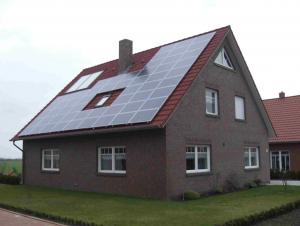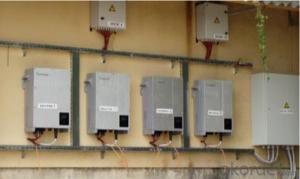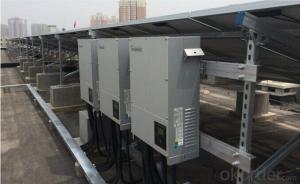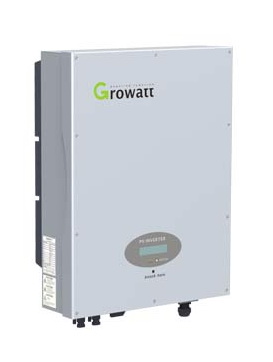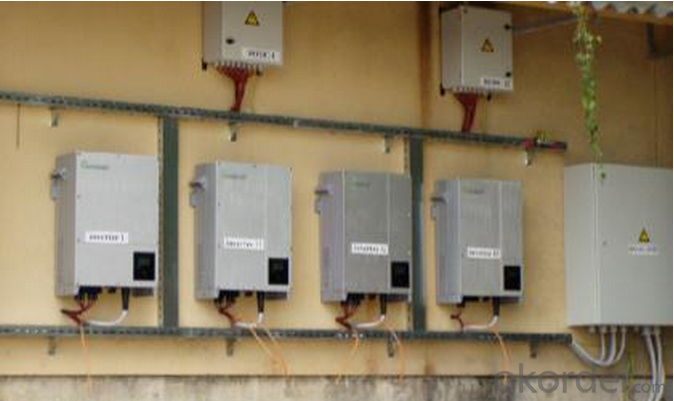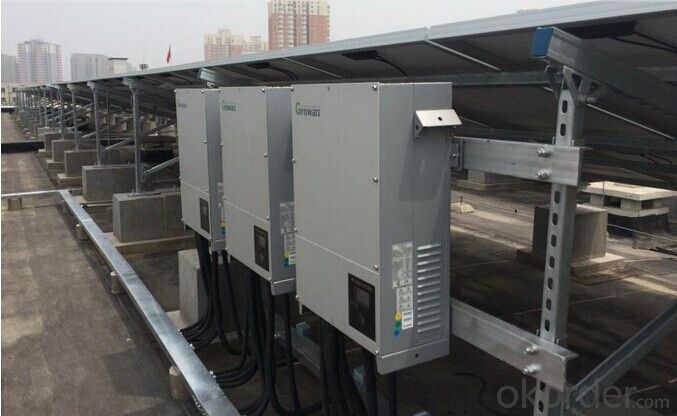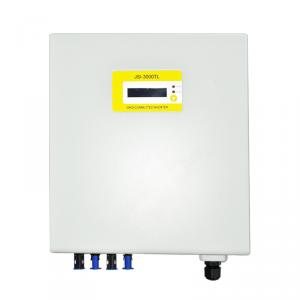Used Grid Connected Solar Inverter 4000-6000UE
- Loading Port:
- Shekou
- Payment Terms:
- TT or LC
- Min Order Qty:
- 10 pc
- Supply Capability:
- 10000 pc/month
OKorder Service Pledge
OKorder Financial Service
You Might Also Like
Grid Connected Solar Inverter 4000-6000UE
Tri-power excellent inverter for small residential and commercial projects
DC input voltage up to 800V
Maximum efficiency of 97.9%
Internal DC switch
Transformerless
Compact design
Multi MPP controller
MTL-string
Bluetooth/ RF technology/ WiFi
Sound control
Easy installation
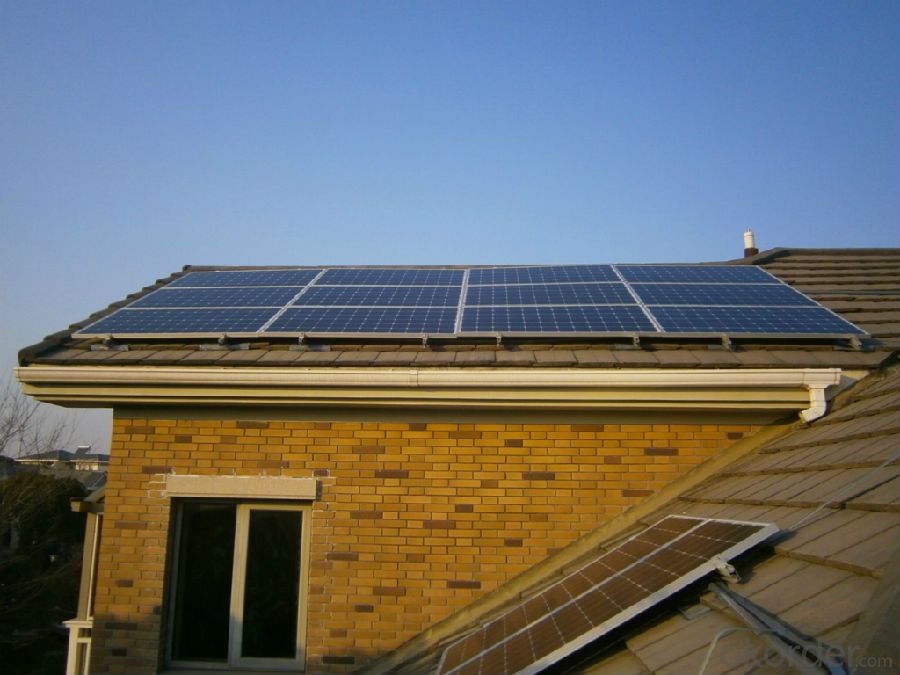
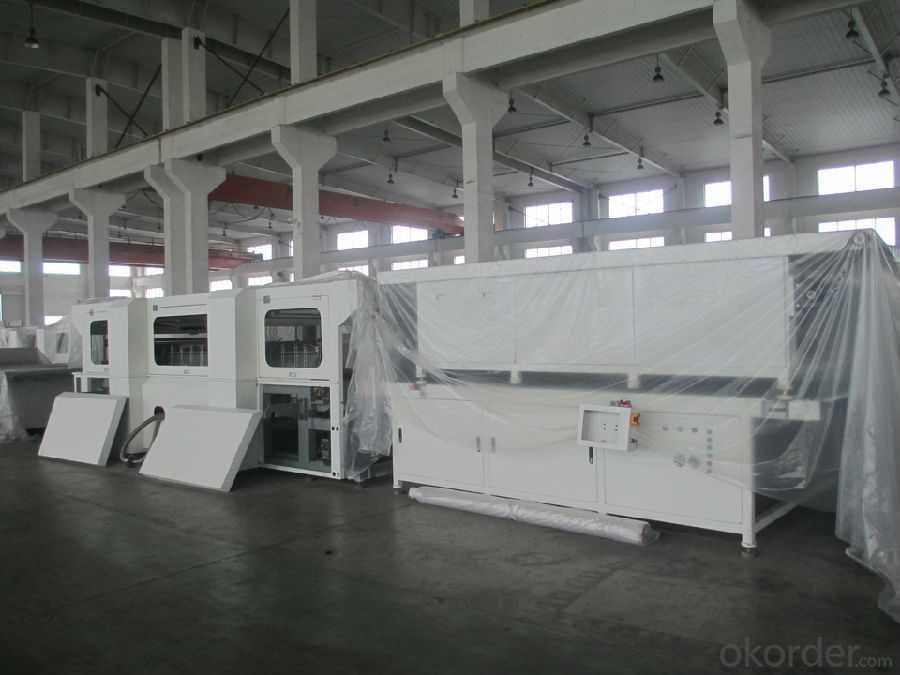
4000UE | 5000UE | 6000UE | |
| Inputdata | |||
| Max.DCpower | 4200W | 5200W | 6300W |
| Max. DC voltage | 800V | 800V | 800V |
| Start Voltage | 150V | 150V | 150V |
| PV voltage range | 140V-800V | 140V-800V | 140V-800V |
| MPP voltage range /Nominal voltage | 200V-800V/ 580V | 200V-800V/ 580V | 200V-800V/ 580V |
| Full load DC voltage range | 250V-750V | 300V-750V | 350V-750V |
| Max. input current / per string | 9A/9A | 9A/9A | 10A/10A |
| Number of independent MPP trackers/strings per MPP tracker | 2/1 | 2/1 | 2/1 |
Output (AC) |
| Rated AC output power | 4000W | 5000W | 6000W |
| Max. AC apparent power | 4000VA | 5000VA | 6000VA |
| Max. output current | 6.4A | 7.9A | 9.3A |
| Max. short-circuit current | 20A | 20A | 20A |
| AC nominal voltage ;range | 230/400V;184-275V | 230/400V;184-275V | 230/400V;184-275V |
| AC grid frequency; range | 50Hz,60Hz; ±5Hz | 50Hz,60Hz; ±5Hz | 50Hz,60Hz; ±5Hz |
| Displacement power factor configurable | 0.9leading-0.9lagging | 0.9leading-0.9lagging | 0.9leading-0.9lagging |
| THDI | <3% | <3% | <3% |
| Grid connection type | 3/N/PE,3W+PE(opt) | 3/N/PE,3W+PE(opt) | 3/N/PE,3W+PE(opt) |
| Efficiency | |||
Max.efficiency | 97% | 97.4% | 97.5% |
| Features | |||
DC connection AC connection Display | H4/MC4(opt) Screw terminal LCD opt/opt/opt | H4/MC4(opt) Screw terminal LCD yes/yes/ opt/opt/opt yes/opt | H4/MC4(opt) Screw terminal LCD yes/yes/ opt/opt/opt yes/opt |
| Generaldata | |||
Dimensions(W/H/D) in mm | 433/566/195 | 433/566/195 31.1KG | 433/566/195 31.1KG |
| Certificates and ApprovalsCE, VDE0126-1-1, VDE-AR-N4105, IEC 62109-1/-2, C-tick, AS/NZS 3100, AS4777, EN61000-6-2 , EN61000-6-3, IEC61727, IEC62116, G83, EN50438 |
- Q: Can a solar inverter be used with a solar-powered air cooling system?
- Yes, a solar inverter can be used with a solar-powered air cooling system. The solar inverter would convert the direct current (DC) electricity produced by the solar panels into alternating current (AC) electricity, which can then be used to power the air cooling system. This allows the system to operate efficiently and effectively using solar energy.
- Q: Installation and maintenance of photovoltaic grid - connected inverter
- photovoltaic systems Power generation system used in the cable must be connected firmly, good insulation and specifications appropriate.
- Q: What is the role of a solar inverter in a community solar project?
- The role of a solar inverter in a community solar project is to convert the direct current (DC) electricity generated by the solar panels into alternating current (AC) electricity that can be used by the community. It ensures that the electricity produced is compatible with the electrical grid and can be distributed to homes and businesses. Additionally, the inverter helps to monitor and optimize the performance of the solar power system, maximizing energy production and efficiency.
- Q: Can a solar inverter be used in a community solar project?
- Yes, a solar inverter can be used in a community solar project. A solar inverter is an essential component of a community solar project as it converts the direct current (DC) electricity generated by the solar panels into alternating current (AC) electricity, which can be used by the community or fed back into the grid.
- Q: Are solar inverters weatherproof?
- Yes, solar inverters are weatherproof. They are designed to withstand various weather conditions including rain, snow, and extreme temperatures. The enclosures of solar inverters are typically made of durable materials that provide protection against moisture and other environmental factors.
- Q: How does a solar inverter communicate with other devices?
- A solar inverter communicates with other devices through various communication protocols such as Wi-Fi, Bluetooth, Ethernet, or RS485. These protocols allow the inverter to connect and exchange information with devices such as monitoring systems, smart meters, or home automation systems. This communication enables real-time monitoring, data logging, and control of the solar energy system.
- Q: Can a solar inverter be used with a solar-powered water desalination system?
- Yes, a solar inverter can be used with a solar-powered water desalination system. A solar inverter is responsible for converting the direct current (DC) power generated by solar panels into alternating current (AC) power, which is required to operate most electrical appliances and systems. In the case of a solar-powered water desalination system, the solar inverter can be used to convert the DC power generated by solar panels into AC power to run the various components of the desalination system, such as pumps, motors, and control systems.
- Q: Solar grid inverter does not merge into the grid, direct access to the load to the load power supply?
- Inverter is the DC power (battery, battery) into alternating current (usually 220V, 50Hz sine wave). It consists of inverter bridge, control logic and filter circuit
- Q: Can a solar inverter be used with a single solar panel?
- Yes, a solar inverter can be used with a single solar panel. The purpose of a solar inverter is to convert the direct current (DC) generated by the solar panel into usable alternating current (AC) electricity. Whether you have one or multiple solar panels, a solar inverter is necessary to convert the DC power into AC power that can be used to power electrical appliances or be fed back into the grid.
- Q: Can a solar inverter be used with thin-film solar panels?
- Yes, a solar inverter can be used with thin-film solar panels. Thin-film solar panels have a different structure and composition compared to traditional crystalline silicon panels, but they still generate DC electricity that needs to be converted into AC for use in homes or businesses. A solar inverter is responsible for this conversion process, regardless of the type of solar panels used.
Send your message to us
Used Grid Connected Solar Inverter 4000-6000UE
- Loading Port:
- Shekou
- Payment Terms:
- TT or LC
- Min Order Qty:
- 10 pc
- Supply Capability:
- 10000 pc/month
OKorder Service Pledge
OKorder Financial Service
Similar products
Hot products
Hot Searches
Related keywords


